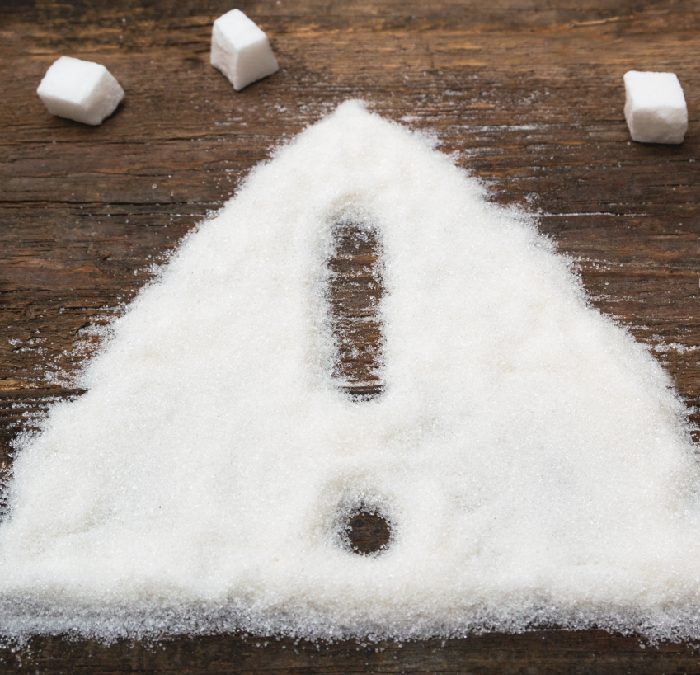Given that added sugar contributes to diabetes and heart disease, it’s important to understand where added sugars in our food are hiding and how to make informed decisions about selecting foods with less added sugar.
It’s been reported that adults who are 20 and older consume, on average, more than 17 teaspoons (290 calories) of hidden sugars each day! These hidden sugars (or “added sugars”) are not just found in the usual places like soda, sports drinks, or fruit juices. Added sugar is found in foods we believe are good for us — instant oatmeal, granola bars, and the salad dressing for the healthy salad we ordered!
While we know that there is a robust association between consuming sugar and diabetes, we now know that consuming too much sugar can also negatively affect cardiovascular health. The American Heart Association recommends that men consume no more than 9 teaspoons of added sugar per day and that women consume no more than 6 teaspoons of added sugar per day. Given that added sugar contributes to diabetes and heart disease, it’s important to understand where added sugars in our food are hiding and how to make informed decisions about selecting foods with less added sugar.
Why is Sugar Bad for You?
Sugar is added to food to make it taste better and to satisfy the reward system in our brains — so the more we eat, the more we crave. Sugar is high in calories (1 gram has ~4 calories) and devoid of nutritional value.
Sugar leads to spikes in blood sugar (hyperglycemia). Hyperglycemia can lead to insulin resistance. Insulin is implicated in controlling glucose (blood sugar); so, if you become insulin resistant, your cells do not respond normally to insulin. When your cells don’t allow glucose to enter, it builds up in your blood and this can lead to type 2 diabetes.
Although the exact way sugar negatively affects heart health is still being investigated, doctors do know that your liver metabolizes sugar the same way it metabolizes alcohol and eventually converts it into fat and weight gain. This can lead to fatty liver disease. Sugar also leads to chronic inflammation and an increase in blood pressure, each of which are associated with heart disease.
What are some Examples of Foods that Contain Added Sugars?
- Breakfast foods: cereals, granola bars, instant oatmeal, and flavored yogurt
- Beverages: soda, sports drinks, fruit juices
- Condiments: ketchup, relish, salsa, barbeque sauce, pasta sauce, and salad dressing
- Snacks: cookies, energy bars, crackers, ice cream, candy, crackers, and flavored nuts
Reduce Sugar in Your Diet
Reading nutrition labels on foods can help steer you in a healthy direction. The nutrition label on foods reports calories, fat, cholesterol, etc. in grams and in percent of daily value. The daily value (DV) is a guideline for how much of a nutrient to consume or not to exceed. Key elements of nutrition labels are:
- Serving size: this tells you how much (in cups, grams, or ounces) of a particular food equals one serving.
- Amount per serving: this tells you many calories are in one serving. One serving is not always the same as the entire package, so read labels carefully. 100 calories might sound like a good deal, but the package might contain 8 servings, so if you eat the entire package, you just ate 800 calories and eight times the amount of everything listed on the nutrition label!
- Total sugars: this tells you how much sugar is occurring naturally in the food.
- Added sugars: this tells you how much sugar was added during processing. This is not the same as total sugars. Added sugars are those sugars (e.g., sucrose or dextrose) that have been added in during processing. Foods that have a daily value (DV) of five (5) percent or less are considered a low source of added sugar. Foods that have a DV of 20 percent or higher are considered a high source of added sugar.
Are All Sugars Bad?
Sugar does provide our body with energy, and it is a type of carbohydrate. Carbohydrates are a macronutrient, and our bodies do need them for proper functioning. There are two different types of sugar: monosaccharides (simple sugars; one molecule) and disaccharides (two molecules). Simple sugars include glucose, fructose and galactose; disaccharides include sucrose (glucose molecule + fructose molecule), lactose (glucose molecule + galactose molecule), and maltose (two glucose molecules).
Fructose, glucose, and sucrose occur naturally in fruit and vegetables, though we don’t always think about sugar being in our vegetables! Fructose is found in vegetables like artichokes, asparagus, and broccoli; sucrose is found in vegetables like sweet potatoes, onions, and sweet corn. Certainly, eating fruits and vegetables are part of a healthy diet. Giving up fresh fruit and vegetables to avoid sugar is not the way to go. Your body does need some sugar, so it’s best to get it in its natural form via fruits and vegetables. Rather than asking if all sugar is bad, a better question might be, “How can I avoid added sugar?”
How to Satisfy your Sweet Tooth while Minimizing Sugar Consumption
One way to satisfy your sweet tooth is to swap sugar for an alternative. Some sugar swaps include:
- Use unsweetened applesauce as a substitute for some of the sugar in a recipe
- Make your own salad dressing with red wine vinegar, balsamic vinegar, extra virgin oil, or lemon juice
- Swap flavored yogurt with plain yogurt and honey
- Swap instant oatmeal for steel cut oats topped with fresh fruit, cinnamon, or bananas
- Look for products that have “no sugar” added on the label. You should still read the nutrition label, but swapping out your usual condiments for no-sugar added condiments is a good start
Removing added sugar from your diet can be challenging. When possible, opt for fresh fruits and vegetables and avoid processed and ultra-processed foods and sugary drinks and snacks. Fresh fruits and vegetables have natural sugar, so be sure to pay attention to serving sizes, even for these healthy foods. When shopping, pay attention to labels, and make choices that will not only reduce your total sugar but also not add to your daily sugar intake. You can plan your trip to the grocery store ahead of time by looking up nutritional labels for your favorite foods online. Even the smallest changes — such as swapping out a can of soda for water — can make a big difference. Sugar can be sneaky, but with some patience, perseverance, and practice, you can reduce the amount of added sugar in your diet.
Before starting any change in diet or exercise program be sure to consult with your health care provider to determine the changes that are best for you.
About the Author: Dr. Dawn M. Sweet has over 20 years of experience in the field of communication. Sweet has given several invited talks to and workshops for academic and private sector audiences on the role of nonverbal and verbal communication in achieving positive outcomes and mitigating bias. Her research has been published in several top ranked peer-review journals, and it has been featured on NPR’s River to River / All Things Considered, Buzzfeed, and Science Daily. Her research has also been used to inform expert testimony.
The information provided on this platform is intended for informational purposes only. It is not a substitute for professional medical advice, diagnosis, or treatment. Always seek the advice of your physician or other qualified health provider with any questions you may have regarding a medical condition. Never disregard professional medical advice or delay in seeking it because of something you have read on this platform. Furthermore, the information provided here has not been reviewed or approved by a health care professional. Any reliance you place on such information is strictly at your own risk. We do not endorse or guarantee the accuracy, completeness, or usefulness of any information provided. It’s important to consult with a qualified health care professional before making any changes to your diet, exercise, medication, or treatment regimen. Reliance on any information provided on this platform is solely at your own risk.



